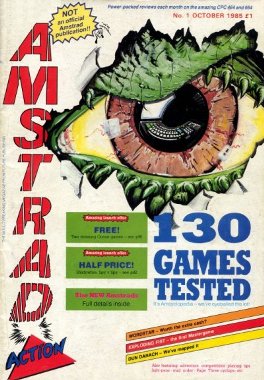
Amstrad Action was a monthly magazine, published in the United Kingdom, which catered to owners of home computers from the Amstrad CPC range and later the GX4000 console.
Davidson & Associates, Inc. was an American developer of educational software based in Torrance, California. The company was founded in 1984 by husband-and-wife Bob and Jan Davidson, the latter of whom led the company as president until January 1997. Specializing in the production of edutainment software, the company was acquired by CUC International in February 1996 and served as the base for CUC's CUC Software division, being made responsible for the sales and distribution of the combined company.
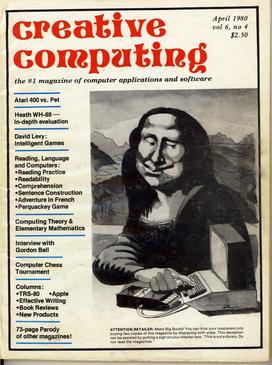
Creative Computing was one of the earliest magazines covering the microcomputer revolution. Published from October 1974 until December 1985, the magazine covered the spectrum of hobbyist/home/personal computing in a more accessible format than the rather technically oriented Byte.

Carmen Sandiego is a media franchise based on a series of computer video games created by the American software company Broderbund. While the original 1985 Where in the World Is Carmen Sandiego? video game was classified as a "mystery exploration" series by creators and the media, the series would later be deemed edutainment when the games became unexpectedly popular in classrooms. The franchise centers around the fictional thieving villain of the same name, who is the ringleader of the criminal organization V.I.L.E.; the protagonists are agents of the ACME Detective Agency who try to thwart the crooks' plans to steal treasures from around the world, while the later ultimate goal is to capture Carmen Sandiego herself.
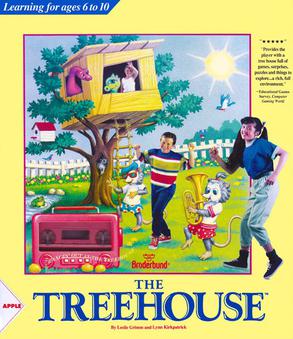
The Treehouse is a point-and-click educational video game for MS-DOS and then ported to Mac and the FM Towns, with Windows versions arriving later. Following the success of The Playroom, Broderbund created The Treehouse, which provides more content and furthers the user's ability to explore. First released in 1991, most copies were sold in educational supply stores rather than mainstream stores that sold computer software; it included a sing-along cassette tape. It was re-released in 1996 for Windows 3.1 and Windows 95. Although the Windows version has the same general activities, the characters, interface, and locations are different.

The Mattel Children's Discovery System is an early electronic educational toy product released by Mattel in 1981. The Children's Discovery System was targeted toward children aged 6 to 11 and mimicked the look of a contemporary consumer-grade computer.

Where in Time Is Carmen Sandiego? is a multiplatform video game where players have to travel through time to collect clues and the warrants necessary to capture Carmen Sandiego or her henchmen. The goal of this game is to track Carmen's villains through history and arrest them and ultimately arrest Carmen herself.
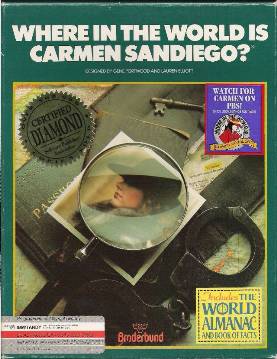
Where in the World Is Carmen Sandiego? is an educational video game released by Broderbund on April 23, 1985. It is the first product in the Carmen Sandiego franchise. The game was distributed with The World Almanac and Book of Facts, published by Pharos Books. An enhanced version of the game was released in 1989, which did not have the almanac-based copy protection and instead used disk-based copy protection. A deluxe version was released in 1990, and featured additional animation and a reworked interface from the original version. Some of the bonus features included digitized photos from National Geographic, over 3200 clues, music from the Smithsonian/Folkways Recordings, 20 villains, 60 countries, and 16 maps. CD-ROM versions for MS-DOS and Mac were released in 1992. A Windows version was released in 1994.

Where in the U.S.A. Is Carmen Sandiego? is an educational video game released by Broderbund in 1986 and is part of the Carmen Sandiego series. The game is a sequel to 1985's Where in the World Is Carmen Sandiego?. A deluxe version with updated graphics and interface was released in 1992 and a remade version was released in 1996. The goal of the game is to track Carmen Sandiego's henchmen across the United States, arrest them, and ultimately arrest Carmen herself. The game received generally positive reviews but some critics compared it unfavorably with its predecessor game, which had a global perspective.

Where in America's Past Is Carmen Sandiego? is the 5th educational video game in the Carmen Sandiego series. It was produced by Broderbund and released in 1991.

Where in Europe Is Carmen Sandiego? is a 1988 European geography-based educational computer game in the Carmen Sandiego detective mystery franchise. It was originally published by Broderbund in 1988 for Apple II, Commodore 64, and MS-DOS, and ported to the Amiga and Mac in 1989. It is the third Carmen Sandiego title, after Where in the World Is Carmen Sandiego? (1985) and Where in the USA Is Carmen Sandiego? (1986). Under the guidance of The Acme Agency's chief, the player completes cases to catch Carmen's henchmen; they accomplish this by traveling to European cities to find clues relating to the crook's last known whereabouts, and by gaining enough character data to issue a warrant of arrest. Once the player has captured all 15 thieves, they can pursue Carmen herself.
A transreality game, sometimes written as trans-reality game, describes a type of video game or a mode of gameplay that combines playing a game in a virtual environment with game-related, physical experiences in the real world and vice versa. In this approach a player evolves and moves seamlessly through various physical and virtual stages, brought together in one unified game space. Alongside the rising trend of gamification, the application of game mechanics to tasks that are not traditionally associated with play, a transreality approach to gaming incorporates mechanics that extend over time and space, effectively playing through a players day-to-day interactions.

Time Riders in American History is a history-themed, educational video game for DOS released by The Learning Company in 1992.
Scetlander was a software publisher which released titles for various 8- and 16-bit home computer systems in the 1980s and 1990s.

Trump Castle is a series of gambling video games published by Capstone Software between 1989 and 1993. The games are named after Trump's Castle hotel-casino in Atlantic City, New Jersey, and were released for Amiga, Atari ST, Commodore 64, Commodore 128, and MS-DOS.
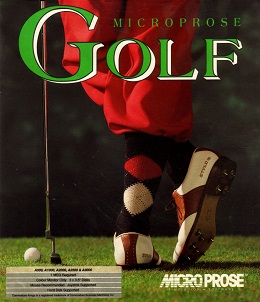
MicroProse Golf is a golf video game developed by The Thought Train and published by MicroProse. It was released in 1991 for Amiga and Atari ST. In 1992, an enhanced MS-DOS version, featuring golf instructor David Leadbetter, was released in the United States as David Leadbetter's Greens and in the United Kingdom as David Leadbetter's Golf. The game's variety was praised, and some critics considered it the best golf game available.

Donald's Alphabet Chase is an educational video game developed by Westwood Associates and published in 1988 by Walt Disney Computer Software. It was released on various home computers including the Amiga, Amstrad CPC, Apple II, Commodore 64, MS-DOS and ZX Spectrum. An Atari ST version was planned by Nathan Software but got no release. The game was released in five different languages including English, Spanish, French, Italian and German.

Where in the World is Carmen Sandiego? is a game within the Carmen Sandiego franchise made for the Prodigy Interactive online service, a "special edition" and Prodigy service adaptation of the 1985 Broderbund educational game of the same name.

Trump Castle II is a 1991 video game published by Capstone Software.

Math Blaster Mystery is a 1989 educational video game developed by Davidson & Associates for the Apple II, Apple IIGS, and Mac and published in 1989. It followed Math Blaster! and Alge-Blaster! as the third entry in the Blaster Learning System franchise.

















